Certainly! The __init__.py file serves as an indicator to Python that a directory should be treated as a package, allowing you to organize your code into modules and submodules. Here’s how you can create the directory structure you mentioned:
- Create an empty file named __init__.py under the model directory.
- Place your Python script (hello-world.py) and any other module files (such as order.py) inside the appropriate directories.
Your directory structure would look something like this:
.
└── project
└── src
├── hello-world.py
└── model
├── __init__.py # This is an empty file
└── order.py
In hello-world.py, you can import SellOrder from the order.py module like this:
from model.order import SellOrder
def main(): order = SellOrder() order.process() if __name__ == "__main__": main()
And in order.py, you might define the SellOrder class:
class SellOrder:
def __init__(self):
pass
def process(self):
print("Processing sell order...")
# Additional logic for processing sell orders
With this structure, Python recognizes the model directory as a package, allowing you to import modules and classes from within it using dot notation, as shown in the import statement (from model.order import SellOrder).






